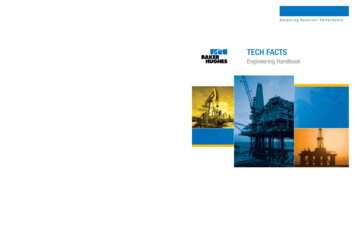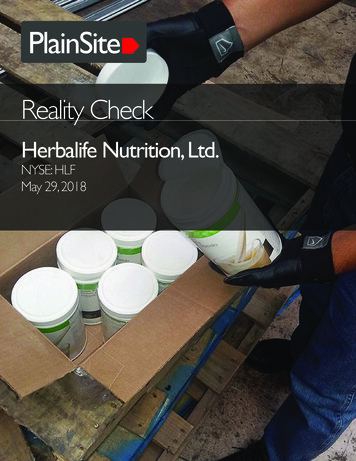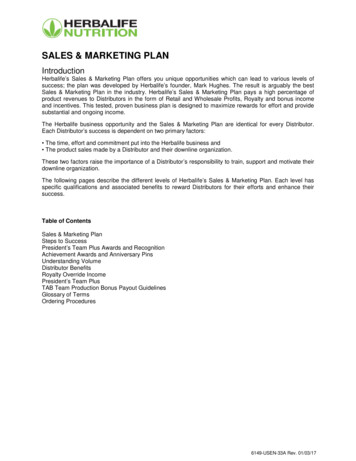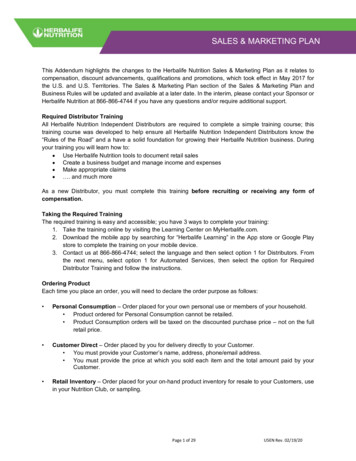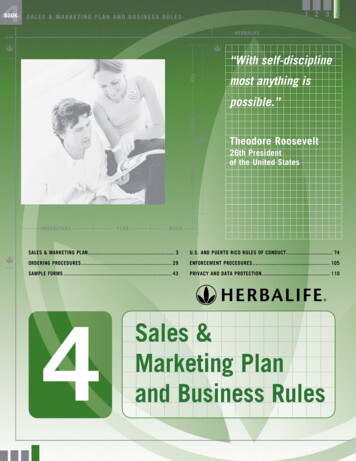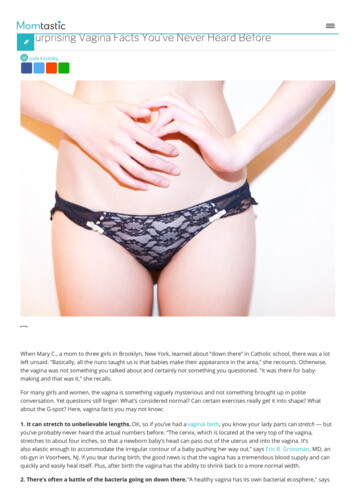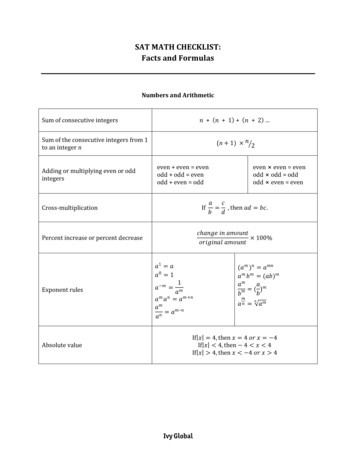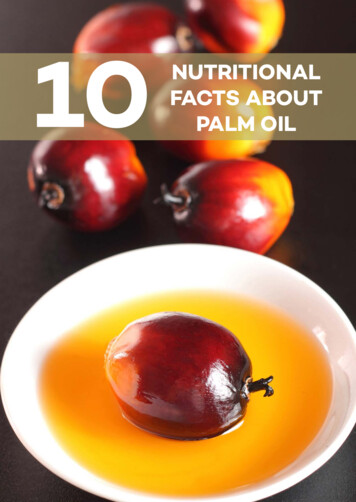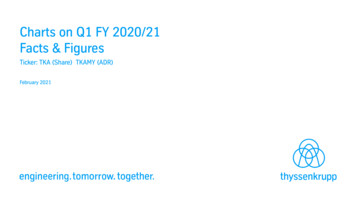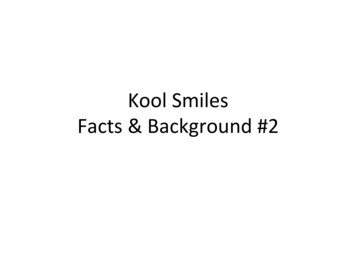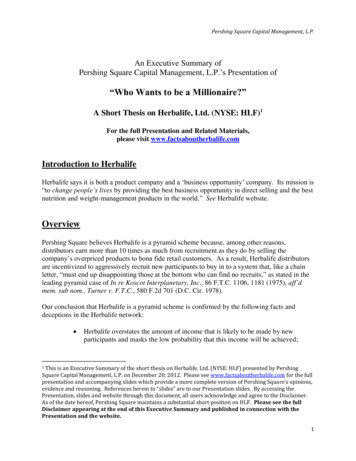
Transcription
Pershing Square Capital Management, L.P.An Executive Summary ofPershing Square Capital Management, L.P.‟s Presentation of“Who Wants to be a Millionaire?”A Short Thesis on Herbalife, Ltd. (NYSE: HLF)1For the full Presentation and Related Materials,please visit www.factsaboutherbalife.comIntroduction to HerbalifeHerbalife says it is both a product company and a „business opportunity‟ company. Its mission is“to change people’s lives by providing the best business opportunity in direct selling and the bestnutrition and weight-management products in the world.” See Herbalife website.OverviewPershing Square believes Herbalife is a pyramid scheme because, among other reasons,distributors earn more than 10 times as much from recruitment as they do by selling thecompany‟s overpriced products to bona fide retail customers. As a result, Herbalife distributorsare incentivized to aggressively recruit new participants to buy in to a system that, like a chainletter, “must end up disappointing those at the bottom who can find no recruits,” as stated in theleading pyramid case of In re Koscot Interplanetary, Inc., 86 F.T.C. 1106, 1181 (1975), aff’dmem. sub nom., Turner v. F.T.C., 580 F.2d 701 (D.C. Cir. 1978).Our conclusion that Herbalife is a pyramid scheme is confirmed by the following facts anddeceptions in the Herbalife network: Herbalife overstates the amount of income that is likely to be made by newparticipants and masks the low probability that this income will be achieved;This is an Executive Summary of the short thesis on Herbalife, Ltd. (NYSE: HLF) presented by PershingSquare Capital Management, L.P. on December 20, 2012. Please see www.factsaboutherbalife.com for the fullpresentation and accompanying slides which provide a more complete version of Pershing Square’s opinions,evidence and reasoning. References herein to “slides” are to our Presentation slides. By accessing thePresentation, slides and website through this document, all users acknowledge and agree to the Disclaimer.As of the date hereof, Pershing Square maintains a substantial short position on HLF. Please see the fullDisclaimer appearing at the end of this Executive Summary and published in connection with thePresentation and the website.11
Pershing Square Capital Management, L.P. Herbalife‟s Statement of Average Gross Compensation of U.S. Supervisors andother recruiting materials are materially deceptive;Herbalife distributors experience an abnormally high failure rate;Taking all expenses into account, including the cost of „business method‟materials, the substantial majority of distributors lose money;Distributors are incentivized to recruit if they wish to achieve „financial freedom‟and the Herbalife „lifestyle‟;Recruits must „apply‟ to become Distributors and agree to a complex set of rulessimply for the right to buy commodity products at a discount to the Company‟shighly inflated Suggested Retail Prices that have little relationship to actual retailprices at which products can be resold;Herbalife has been sued numerous times for being a pyramid scheme and, in somecases, has been found to be a pyramid or to exhibit key characteristics ofpyramids;There is evidence of saturation within key regions and affinity groups that aretargeted by the Company;Herbalife‟s top 1% of distributors earn the vast majority of rewards; andHerbalife distributor compensation scheme is substantially more pyramidal thantypical multilevel marketing companies.Herbalife is in the business of selling dreams, not weight-management products. This isevidenced by its limited R&D and advertising budgets and the inflated Suggested Retail Prices ofits commodity-like products.The only reason Herbalife can sell 1.8bn of nutrition powder per year is because itsdistributors are buying it with the hope and dream of “achieving financial freedom.”Unfortunately, for the vast majority of Herbalife participants, this dream never becomes a reality,and they leave Herbalife with increased debt, a sense of failure, and damaged relationships.Worse yet, because Herbalife targets the most vulnerable populations, including low-incomemembers of various ethnic and minority groups, those who fail at the Herbalife businessopportunity are those who can least afford to.Herbalife: The Product CompanyFounded in 1980, Herbalife claims to be one of the largest consumer product companies in theworld. It is of similar size to Church & Dwight, Energizer, and Clorox. Herbalife is not atypical consumer product company, however. Its gross margins at 80% are more than twice thegross margins of a typical consumer product company. Unlike Church & Dwight, Energizer, andClorox, Herbalife lacks a portfolio of household name brands.2
Pershing Square Capital Management, L.P.Herbalife‟s top-selling product, Formula 1, supposedly generated 1.8bn in “retail sales” in2011, according to the company, roughly comparable to Oreo, Charmin, Crest, Gerber,Palmolive, Listerine and Clorox. Surprisingly, however, few people have ever heard of Formula1. The brand does not even have a proper logo. (See slide ds/2013/01/Who-wants-to-be-aMillionaire.pdf#page 12)Formula 1 is a nutritional shake mix like Lean Shake, Slim-Fast or Ensure. Unlike thesecomparable products, Formula 1 is not sold in stores and lacks a “Ready-To-Drink” offering.Despite this competitive disadvantage, Formula 1 supposedly generated 1.8bn in retail sales in2011 while Ensure (Abbott Labs), Slim-Fast (Unilever) and Lean Shake (GNC) only sold 300mm of nutrition powder, combined.Formula 1 is expensive relative to comparable products. For a 200-calorie serving, Formula 1costs nearly three times as much as Ensure or Slim-Fast, and nearly twice as much as LeanShake. Herbalife‟s other products are similarly expensive. A multivitamin tablet from Herbalifesupposedly retails for 26 cents, whereas Centrum (Pfizer) can be purchased for 6 cents per tablet.Herbalife‟s advertising and R&D are immaterial. Herbalife‟s products are commodities thatshould have little to no pricing power. The company says it spends “de minimis” amounts toadvertise its products, and its spending on R&D is “not material.”So how does Herbalife sell so much of its unadvertised, commodity products at such inflatedprices?Answer: Herbalife bundles its products with a „business opportunity.‟Herbalife: The Business OpportunityWhat we‟re doing at Herbalife, is we‟re buildingthe best business opportunity on the face of the earth.- CEO Michael Johnson2What is the Herbalife business opportunity? Said differently, what is Herbalife really selling?Extravagant Promises. Herbalife Independent Distributor presentations market Herbalife as anopportunity to “be your own boss,” to “work from home,” to “achieve financial freedom,” tocreate perpetual income and to improve one‟s lifestyle.Promoting a Lifestyle. Herbalife recruits are shown videos or brochures of the lifestyles of themost successful Herbalife distributors – the top 0.1%. In these videos, Herbalife distributors livein mansions, drive Ferraris and live fabulous lifestyles. “Anyone can do it,” Herbalife says, if22010 First Quarter Earnings Call3
Pershing Square Capital Management, L.P.they just work hard and dream big. m-llc/doran-andrys-chairmans-club-member 3Misleading Testimonials. Herbalife-published magazines are filled with testimonials ofsuccessful distributors. These testimonials follow a simple rags-to-riches formula. BeforeHerbalife: “I had my back against the wall. I needed to make some money!” After Herbalife: “Inthe first month we were able to save our home. Herbalife saved us from bankruptcy!” Anotherimportant theme: “If I can do it, anybody can. I only have a high-school education and nobusiness background.” (See slide 209-212: 013/01/Who-wants-to-be-a-Millionaire.pdf#page 209)In HLF‟s Herbalife Today magazine from 1997 through 2004, there were 392 testimonials,boasting average earnings of 178,000 per year.Overstated Opportunity for Profits. These testimonials and other Herbalife distributormarketing materials create the perception for potential recruits that is inconsistent with theirlikelihood of success. They are led to believe that these results are not only possible butprobable.We believe the typical distributor earns less than 100 per year before expenses. Only the top 0.1% of Herbalife distributors earn enough to “achieve financial freedom.”Blaming the Victims. According to the company‟s website, Herbalife tells millions of people itsopportunity will let you “earn what you‟re worth.” That phrase allows Herbalife to blame thedistributors when they fail, even though, unbeknownst to the recruits, they never had areasonable likelihood of success in the first place. Apparently, Herbalife believes the vastmajority of its millions of distributors are “worth” next to nothing.What is a Pyramid Scheme?In 2002, Dr. Peter J. Vander Nat, a Senior Economist at the FTC and expert witness for theagency in pyramid cases, defined a pyramid scheme as follows:If an organization sells goods or services to the public and the participants in theorganization obtain monetary benefits from (1) recruiting new members and (2) sellingthe organization‟s goods and services to consumers, the organization is deemed apyramid scheme if the participants obtain their monetary benefits primarily fromrecruitment rather than the sale of goods and services to consumers.43Our website includes many more examples of these lifestyle and income ry/promoting-the-business-opportunity/Vander Nat, Peter J. and William W. Keep, “Marketing Fraud: An Approach for Differentiating MultilevelMarketing from Pyramid Schemes,” in Journal of Public Policy and Marketing, Vol. 21 (1), Spring 2002, at 13951.44
Pershing Square Capital Management, L.P.Recruiting Rewards v. Retail Profits. To apply that standard, one examines the monetaryrewards received by distributors. When a distributor gets paid for recruiting a new distributor,that is a recruiting reward. It is still a recruiting reward even if the commission is based upon therecruit‟s purchase of some products – because we don‟t know at that point if any of thoseproducts will ever be sold at retail. If the new distributor makes a profit selling HLF products toan actual consumer, that is retail profit.This definition makes intuitive sense. If all participants follow the same set of incentives, and ifthose incentives primarily encourage recruiting, then the optimal decision for most, if not all,participants will be to recruit new participants into the scheme. If all participants focus theirefforts on recruiting new participants, saturation – the inability to find new recruits – isinevitable.Pyramid Schemes are Illegal. “Pyramid schemes are said to be inherently fraudulent becausethey must eventually collapse. Like chain letters, pyramid schemes may make money for thoseat the top of the chain or pyramid, but „must end up disappointing those at the bottom who canfind no recruits.‟” (see Webster v. Omnitrition, 79 F.3d 776, 782 (9th Cir. 1996), quoting Koscot).In a pyramid scheme, as in a chain letter, the money at the top is made from the losses of peopleat the bottom. “[T]he very reason for the per se illegality of the Endless Chain [pyramid]schemes is their inherent deceptiveness and the fact that the „futility‟ of the plan is not „apparentto the consumer participant.‟” Id. at 782. Regulators and prosecutors, however, need not waituntil a pyramid actually collapses before stepping in to prevent losses to victims along the way.Why We Believe Herbalife Meets the Legal Definition of a PyramidHerbalife has already been Found to be a Pyramid. In 2011, following seven years ofproceedings examining Herbalife‟s marketing plan, a Belgian court found that Herbalife is apyramid scheme. Test-Aankoop v. Herbalife International Belgium [Comm. Ct. Brussels], Nov.23, 2011, AR 2004/7787, No. JC-DC/27.Moreover, in a 2009 decision, in considering an endless-chain (pyramid) claim under Californialaw, a federal judge opined:Herbalife‟s entire business model appears to incentivize primarily the payment ofcompensation that is „facially unrelated to the sale of the product to the ultimate usersbecause it is paid based on the suggested retail price of the amount ordered from [HLF],rather than based on actual sales to consumers.‟5Herbalife v. Ford, Memorandum & Order Regarding Cross-Motions for Summary Judgment, No. CV 07-02529,slip op. at 16 (C.D. Cal. Aug. 25, 2009). While the Ford case was disposed of on other grounds – namely, theparties challenging Herbalife as a pyramid failed to show that they were victims of the scheme, as opposed toparticipants who profited from it – the Court’s finding was not disturbed or changed.55
Pershing Square Capital Management, L.P.Recruiting Rewards Far Outweigh Any Retail Profit. Herbalife distributors “obtain theirmonetary benefits primarily from recruitment rather than the sale of goods and services toconsumers,” meeting the definition of a pyramid scheme, quoted above.We believe that while the vast majority of distributors earn little to no income, those who do arerewarded primarily for recruiting new distributors. Based on public data and the assumptionsdetailed in our presentation, we believe that recruiting-related rewards constitute over 90% of theearnings of Herbalife distributors.Herbalife has no Genuine Data Demonstrating Retail Sales. Herbalife‟s 10-K acknowledgesamong its risk factors that it must comply with consumer-protection and pyramid regulations.Regulations applicable to network marketing organizations generally are directed atpreventing fraudulent or deceptive schemes, often referred to as „pyramid‟ or „chainsales‟ schemes, by ensuring that product sales ulti
Herbalife Independent Distributor presentations market Herbalife as an opportunity to “be your own boss,” to “work from home,” to “achieve financial freedom,” to create perpetual income and to improve one‟s lifestyle. Promoting a Lifestyle. Herbalife recruits
